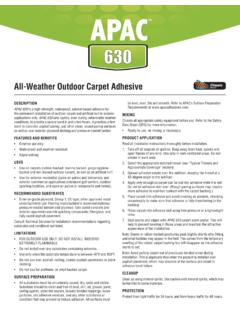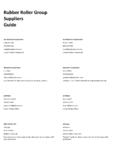Transcription of Adhesive Bonding of Thermoplastic Materials-2013
1 Adhesive Bonding of Thermoplastic Materials There are several different types of adhesives suitable for plastics. They include cyanoacrylates, urethanes, acrylics and epoxies. Each type of Adhesive offers its own benefits. Cyanoacrylates These families of adhesives are room temperature curing materials that do not require mixing. They produce bonds within a few minutes. After one hour, some formulations can achieve 89% of their bond strength. This Adhesive forms a Thermoplastic bond with excellent adhesion to most substances. For some materials, a primer or surface roughening will enhance bond strengths. The temperature range for this class of Adhesive is from 40 F to 250 F. Cyanoacrylates have excellent shear and tensile strengths. They do have, however, poor solvent resistance and poor peel strength. Cyanoacrylates can attack certain plastics, such as polycarbonate, causing chemical stress cracks.
2 Suppliers include: Lord Corporation: 1-814-868-3611 x 3277. 3M Corporation: 1-800-362-3550. Loctite: 1-800-LOCTITE. Permabond: 1-201-567-9494. Acrylic Adhesives Acrylic adhesives are solvent free products that form a thermoset polymer bond with plastics. There are several types of acrylic adhesives. Light curing acrylics will produce bonds upon exposure to light. Curing times and bond strengths can be varied through intensity and exposure to the curing light. The bonds have good weather resistance, however, excessive oxygen exposure during Bonding will produce weak bonds. Another type of acrylic Adhesive is a two-part acrylic that offers good environmental resistance and good Adhesive strengths. Curing times can be shortened with the application of heat. Effective temperature resistance up to 400 F is achievable for some formulations. A third type of acrylic uses methacrylates for improved performance.
3 During the curing process the Adhesive penetrates the substrate. In addition this Adhesive has good cold impact performance and high shear strength. Suppliers include: Loctite: 1-800-LOCTITE. ITW Plexus Corporation: 1-800-851-6692. Permabond: 1-201-567-9494. Urethanes Urethane adhesives are available in one and two part systems. Curing times can be regulated with the application of a catalyst or heat. Minimal surface preparation is needed. Adhesive bonds are flexible and have good mechanical properties. Bond strengths are retained up to 250 F. Suppliers include: Lord Corporation: 1-814-868-3611 x 3277. 3M Corporation: 1-800-362-3550. Epoxies Epoxies are thermosetting adhesives that have been available for years. They have been used extensively in the automotive industry for body panels and components. Epoxies are usually two part mixes, one part epoxy the other a catalyst or curing agent.
4 The addition of heat can accelerate curing times. Bonds tend to be strong yet brittle, however, toughened formulations are available for improved impact resistance. Epoxies can be used for most plastics, rubbers, wood, and metals. Adhesive bonds are typically stronger than the substrates. Epoxy adhesives offer excellent resistance to a variety of chemicals including dilute acids, bases, solvents, and oils. In addition, these adhesives offer good weather-ability. Specialized systems are heat resistant to 400 F. Suppliers include: Lord Corporation: 1-814-868-3611 x 3277. 3M Corporation: 1-800-362-3550.. Duo-Pack , Scotchweld are registered trademarks of the 3M Corporation.. Fusor , Tyrite are registered trademarks of the Lord Corporation.. Loctite , Prism , Black Max are registered trademarks of the Loctite Corporation.. Plexus is a registered trademark of ITW Plexus Corporation.
5 Quickbond , Permabond are registered trademarks of Permabond International Corporation.. Zytel , Delrin , and Vespel are registered trademarks of E. I. DuPont de Nemours Co., Inc.. Celcon and Celanex are registered trademarks of Ticona Division of Hoechst Group.. Ultraform is a registered trademark of BASF Corporation.. Lexan , Noryl , Valox , Cycolac and Ultem are registered trademarks of General Electric Co.. Kynar is a registered trademark of Elf Atochem North America Inc.. Hydex , Hyd-imide HT are registered trademarks of the A. L. Hyde Co.









